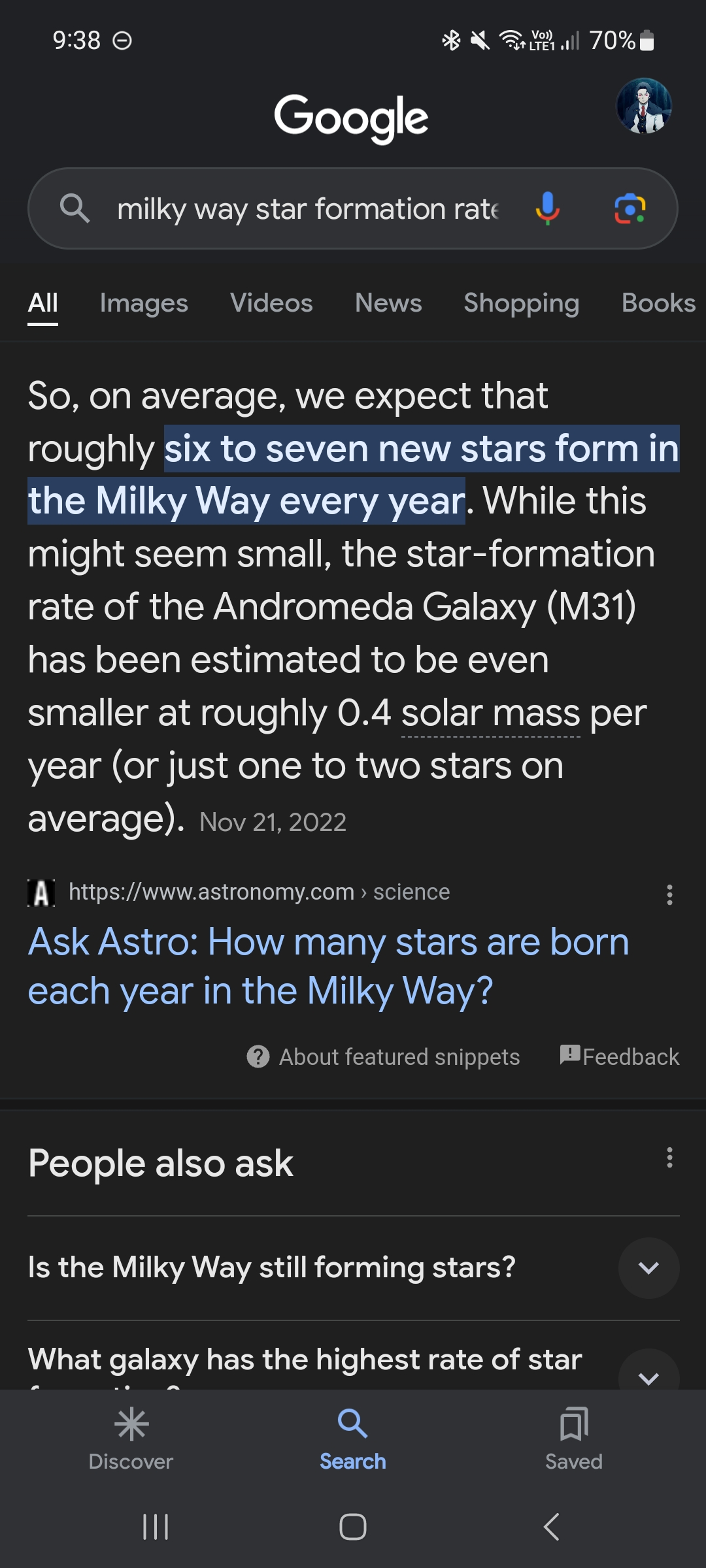This market will be used to calculate R∗ for the Manifold Solves the Drake Equation project. You can read more about the Drake Equation here.
This market is intended to not resolve and functions as a stock ticker tracking the current scientific consensus. It will close intermittently to allow for easy tracking of project and reopen once recordings are taken. If a solid scientific consensus is held over a significant period of time (multiple decades) then it may resolve to that consensus.
Note: due to an error at point of creation, this market is missing a “7 to 8” option. If the answer is ever definitively settled to be in this range, the market will resolve to N/A.
People are also trading
A recent talk: (TL;DR theory overpredicts star formation rate by a factor 100)
TITLE: The Central Problem of Star Formation: Why So Slow?
SPEAKER: Prof. Neal J. Evans II (University of Texas at Austin)
ABSTRACT: The Central Problem of star formation has been clear for over 40 years: simple estimations predict starformation rates more than 100 times what is observed in the Milky Way and other galaxies. Much ingenious theoretical work has been expended to solve this problem, enhancing our understanding of turbulence and feedback in molecular clouds, but the fundamental problem remains. This situation suggests a reconsideration of the basic assumption that underlies the problem: that molecular clouds are bound entities. In the most complete catalog of structures from CO emission maps, most molecular clouds are unbound, ameliorating the problem. Combining this information with theoretical models of how the star formation rate depends on the initial virial parameter, along with considerations of how metallicity affects the conversion of CO luminosity into mass, provides a solution to the Central Problem for the Milky Way. The variation of star formation rate with Galactocentric radius can also be predicted and finds good agreement with the recent results obtained from the Hi-GAL survey.
@Noit in the unlikely event that the SFR in the Milky Way happens to be exactly between 7/yr and 8/yr (or more than 1000/yr), does it resolve N/A?
@ArmandodiMatteo Great spot, yes if the true answer turned out to be 7 to 8 then it would resolve N/A. I’ll update the description to reference this.
In relation to your other questions - they’re good points, but these markets were fairly expensive to set up and don’t see much trading volume, so I’ve no intention of re-creating with different options. If it turned out they were unbearably broken for some reason I’d probably just close them N/A, otherwise they will just trundle on as-is.
@Noit There are big error bars on these estimates, so even if some authoritative work predicts 7.3 or something I expect it to be 7.3 +- 1.4 or something like that. I don’t know whether resolving NA at that point is fair to those who bet up the 6-7 and 8-9 bins.
@mariopasquato I think the idea is for the market to never resolve until we're pretty sure which bin the answer is in
(not that I think the SFR in the Milky Way is stable enough over the timescales that would require...)
@ArmandodiMatteo This, although for clarity of resolution, if the final answer turns out to be e.g. “average of five but +- 3 because it is very inconsistent and the average is a misleading stat” then I’d still resolve 5 as the midpoint of the error range.
7 to 8 is missing
(Also, the binning should be logarithmic and waaay broader -- if it's e.g. 7.2/year we're not going to know whether it's > 7/year or < 7/year at any time soon. I'd suggest having < 0.03, 0.03 to 0.1, 0.1 to 0.3, 0.3 to 1, 1 to 3, 3 to 10, 10 to 30, 30 to 100, 100 to 300, 300 to 1000, >1000.)
@ArmandodiMatteo or, if we feel really confident it's of the order of a few per year, we could use an R5 Renard series: <1.0, 1.0 to 1.6, 1.6 to 2.5, 2.5 to 4.0, 4.0 to 6.3, 6.3 to 10, 10 to 16, 16 to 25, 25 to 40, >40. Any narrower bins than this would be completely ridiculous.
https://arxiv.org/pdf/2308.01330.pdf Take fig. 3, the average by eye seems 10^-2 solar masses /kpc^2 yr and multiply by 100kpc^2 (Earth-galactic center distance is 8kpc, let’s make it 10; the galaxy is much bigger but let’s underestimate since the further you go the less mass there is). You get 1 solar mass/yr. But the stars you form are smaller than the Sun. So 4 or 5/yr is not too far out. Hard to constrain the mass function at low masses anyway (small stars are harder to see).
@JonathanRay we know from stellar physics that luminosity scales with mass \propto 3.5 (in main sequence; the exact exponent depends on whether you are big enough to trigger the CNO cicle or not, at any rate around 3). Since hydrogen available to burn scales with mass, it follows that lifetime scales with mass to the -2.5. This of course for "normal" stars evolving in isolation
Like many things, it seems to occasionally accelerate in bursts, but this article suggests it's about 1 per year right now:
https://astrobites.org/2014/09/30/measuring-galaxy-star-formation/
Results of this market will be used here at first closure:
https://manifold.markets/Noit/how-many-aliens-does-manifold-think?r=Tm9pdA
